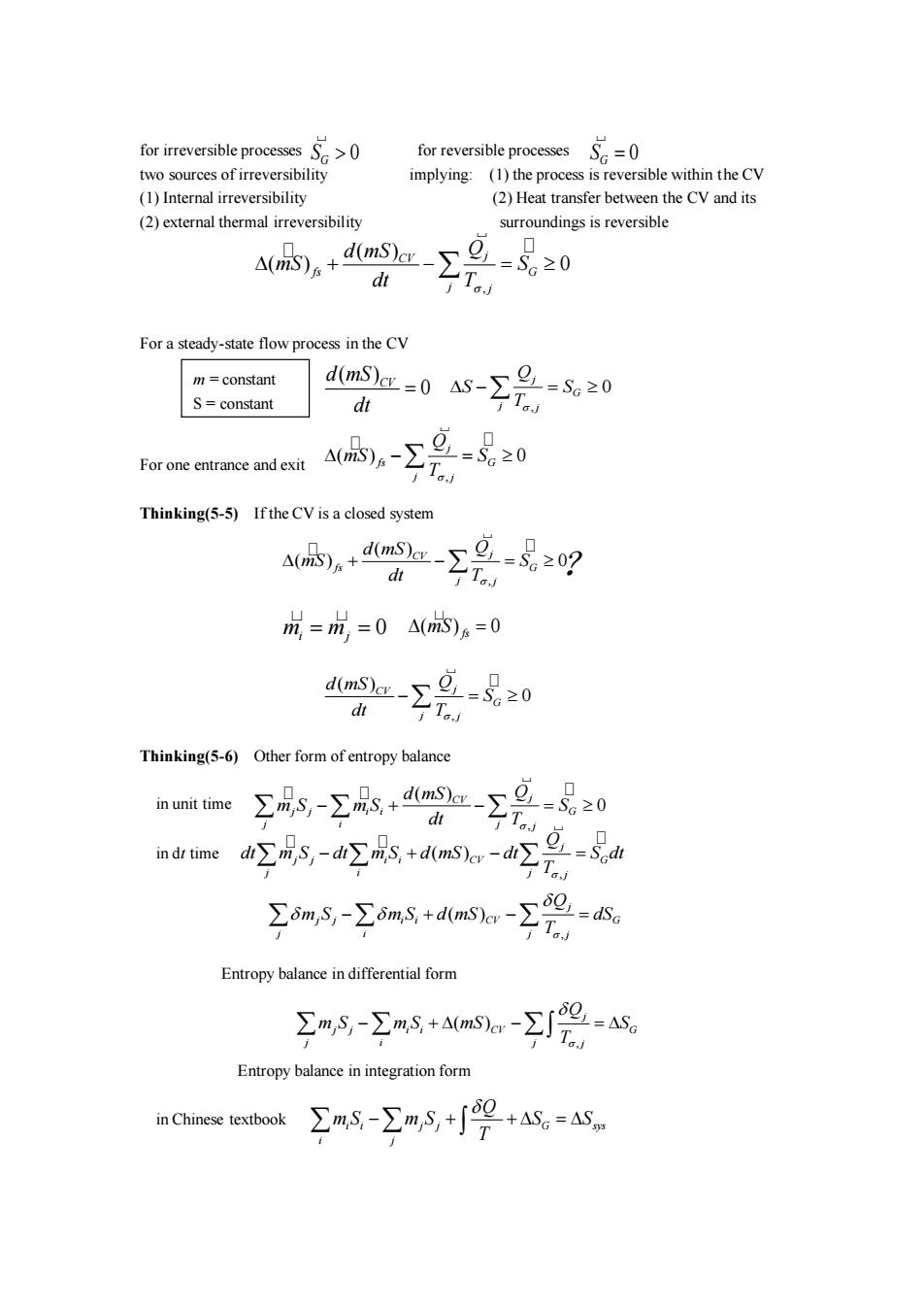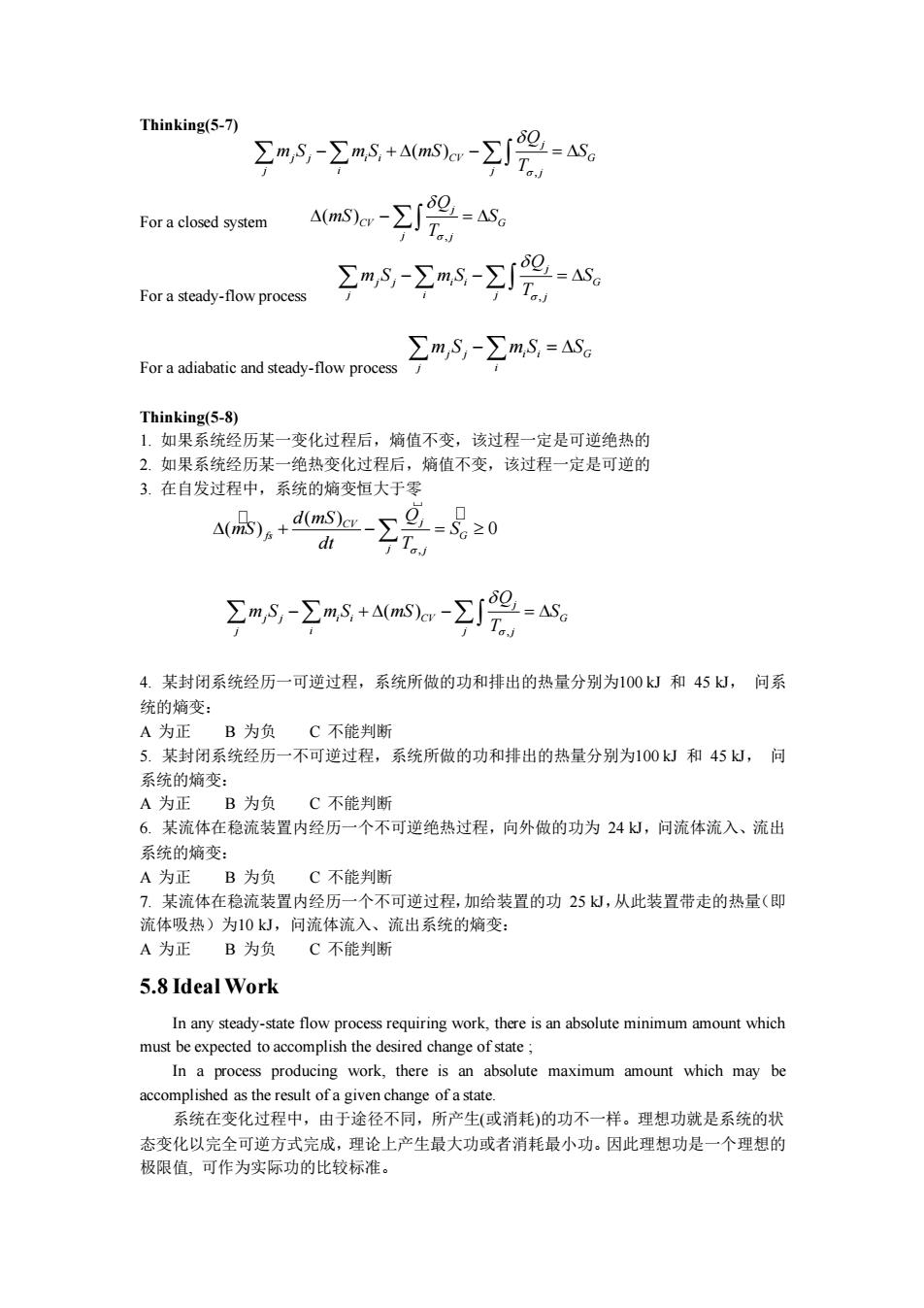
for irreversible processes for reversible processes of irreversibility implying:(1)the process is reversible within theCV (1)Internal irreversibility (2)Heat transfer between the CV and its (2)external thermal irreversibility surroundings is reversible A+0mL-zg-号之0 dt T For a steady-state flow process in the CV m=constant d(mS)=0△s-∑g=S。≥0 S=constant Foronend-∑g=号之0 Thinking(5-5)Ifthe CV is a closed system A+msL-Σg=号≥02 dt T 成=成=0△成)6=0 dmsa-∑g-{≥0 d山 T Thinking(5-6)Other form of entropy balance in unit time -空-%足0 dt ndr tme dr∑is,-∑is+dmsa-dΣ号=$ ∑6mS,-∑6mS+dms-∑2=。 T Entropy balance in differential form m5-工n5+aMm.空2-a Entropy balance in Chinese textbook ∑mS-∑mS+∫2+a,=AS
0 G S , ( ) ( ) 0 CV j fs G j j d mS Q mS S dt T + − = ( ) 0 CV d mS dt = , 0 j G j j Q S S T − = , ( ) 0 j fs G j j Q mS S T − = , ( ) ( ) 0 CV j fs G j j d mS Q mS S dt T + − = , ( ) 0 CV j G j j d mS Q S dt T − = , ( ) 0 CV j j j i i G j i j j d mS Q m S m S S dt T − + − = , ( ) j j j i i CV G j i j j Q dt m S dt m S d mS dt S dt T − + − = , ( ) j j j i i CV G j i j j Q m S m S d mS dS T − + − = , ( ) j j j i i CV G j i j j Q m S m S mS S T − + − = i i j j G sys i j Q m S m S S S T − + + = for irreversible processes for reversible processes two sources of irreversibility implying: (1) the process is reversible within the CV (1) Internal irreversibility (2) Heat transfer between the CV and its (2) external thermal irreversibility surroundings is reversible For a steady-state flow process in the CV For one entrance and exit Thinking(5-5) If the CV is a closed system Thinking(5-6) Other form of entropy balance in unit time in dt time Entropy balance in differential form Entropy balance in integration form in Chinese textbook 0 G S = m = constant S = constant ? 0 m m i j = = ( ) 0 = mS fs

Thinking(5-7刀 Σms-ΣnS+Aw-2-a For a closed system ms-2到2=Aa For a steady-flow process Σ叫5-Ym-2=as ∑m,S,-∑m,S=AS。 For a adiabatic and steady-flow process Thinking(5-8) 1.如果系统经历某一变化过程后,嫡值不变,该过程一定是可逆绝热的 2.如果系统经历某一绝热变化过程后,熵值不变,该过程一定是可逆的 3.在自发过程中,系统的熵变恒大于零 2-2aaa2%-a战 4.某封闭系统经历一可逆过程,系统所做的功和排出的热量分别为100和45,问系 统的熵变: A为正B为负C不能判断 5.某封闭系统经历一不可逆过程,系统所做的功和排出的热量分别为100k)和45,问 系续的培变: A为正B为负 C不能判断 6。某流体在稳流装置内经历一个不可逆绝热过程,向外做的功为24,问流体流入、流出 系统的熵变: A为正B为负C不能判断 7.某流体在稳流装置内经历一个不可逆过程,加给装置的功25从,从此装置带走的热量(即 流体吸热)为10k,问流体流入、流出系统的熵变: A为正B为负 C不能判断 5.8 Ideal Work In any steady-state flow process requiring work,there is an absolute minimum amount which must be expected the desired change of stae In,there maximum mount which may be accomplished as the result of a given change of a state 系统在变化过程中,由于途径不同,所产生(或消耗)的功不一样。理想功就是系统的状 态变化以完全可逆方式完成,理论上产生最大功或者消耗最小功。因此理想功是一个理想的 极限值,可作为实际功的比较标准
, ( ) j j j i i CV G j i j j Q m S m S mS S T − + − = , ( ) j CV G j j Q mS S T − = , j j j i i G j i j j Q m S m S S T − − = j j i i G j i m S m S S − = , ( ) ( ) 0 CV j fs G j j d mS Q mS S dt T + − = , ( ) j j j i i CV G j i j j Q m S m S mS S T − + − = Thinking(5-7) For a closed system For a steady-flow process For a adiabatic and steady-flow process Thinking(5-8) 1. 如果系统经历某一变化过程后,熵值不变,该过程一定是可逆绝热的 2. 如果系统经历某一绝热变化过程后,熵值不变,该过程一定是可逆的 3. 在自发过程中,系统的熵变恒大于零 4. 某封闭系统经历一可逆过程,系统所做的功和排出的热量分别为100 kJ 和 45 kJ, 问系 统的熵变: A 为正 B 为负 C 不能判断 5. 某封闭系统经历一不可逆过程,系统所做的功和排出的热量分别为100 kJ 和 45 kJ, 问 系统的熵变: A 为正 B 为负 C 不能判断 6. 某流体在稳流装置内经历一个不可逆绝热过程,向外做的功为 24 kJ,问流体流入、流出 系统的熵变: A 为正 B 为负 C 不能判断 7. 某流体在稳流装置内经历一个不可逆过程,加给装置的功 25 kJ,从此装置带走的热量(即 流体吸热)为10 kJ,问流体流入、流出系统的熵变: A 为正 B 为负 C 不能判断 5.8 Ideal Work In any steady-state flow process requiring work, there is an absolute minimum amount which must be expected to accomplish the desired change of state ; In a process producing work, there is an absolute maximum amount which may be accomplished as the result of a given change of a state. 系统在变化过程中,由于途径不同,所产生(或消耗)的功不一样。理想功就是系统的状 态变化以完全可逆方式完成,理论上产生最大功或者消耗最小功。因此理想功是一个理想的 极限值, 可作为实际功的比较标准